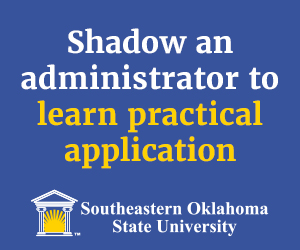Menu
Before You Enroll: Earning Your Master's in Educational Leadership Online

What Is a Master's in Educational Leadership?

A master's in educational leadership is a graduate-level degree designed to prepare teachers and professionals for leadership roles in school systems, districts and education-focused organizations. This degree equips working professionals with the tools to lead schools and shape policy, on a schedule that fits their lives. If you're wondering, "What is a master's in education leadership good for?" the opportunities it provides might surprise you.
Through advanced coursework and real-world applications, the the Master of Education (M.Ed.) in Educational Leadership degrees offered online by Southeastern Oklahoma State University equip future principals, assistant principals and education administrators with the skills needed to improve school performance, support faculty and shape policy. Many programs, including flexible online options, allow working professionals to earn their degree while continuing to teach or manage school responsibilities.
Who Should Consider a Master's in Educational Leadership?

An educational leadership program is designed for individuals who want to influence change across school systems and improve outcomes for students, teachers and communities. Whether you're a classroom teacher ready to expand your impact, a licensed educator seeking principal certification or a professional interested in shaping school policy, this degree offers a direct pathway to leadership roles.
With flexible online options and multiple tracks, it supports a range of career goals in K-12 and beyond. Explore the M.Ed. in Educational Leadership online programs at Southeastern to see how the curriculum supports your specific goals.
Advancing Your Teaching Career
For certified teachers, a master's degree in educational leadership opens doors to advanced roles in school administration, including instructional coordinator, department chair or curriculum lead. The program builds on classroom experience and helps educators expand their influence while staying connected to student learning. Many teachers use the degree to transition into leadership roles that support faculty development and school improvement initiatives.
Preparing for Principal Certification or School Leadership
If your goal is to become a school principal or assistant principal, a master's in educational leadership is often required for licensure. Most states expect principal candidates to complete a state-approved leadership program and demonstrate core competencies in instructional leadership, school law, budgeting and personnel management. Completing an M.Ed. program with a professional track, often including a practicum, can position you for principal certification and day-one readiness for managing a school community.

"I want my students to be well grounded in the concept of servant leadership. I want my students to have real, practical ideas and field experiences for leadership."
—Dr. Jerry Stout, SOSU Educational Leadership Program Coordinator
Transitioning Into Administration, Policy or Coordination
Not all educational leadership students come from the classroom. Professionals from related fields, such as counseling, special education or education technology, may pursue the degree to prepare for administrative or district-level positions. An M.Ed. program with an academic track is especially well suited for those interested in curriculum development, educational policy or coordination roles at the school, district or state level.
What Will You Learn in an Educational Leadership Program?
A master's in educational leadership prepares students for the multifaceted responsibilities of managing schools, programs and systems. Through targeted coursework, students gain a strong foundation in curriculum development, instructional leadership, school law and organizational strategy. Most programs also emphasize practical competencies that directly apply to school settings, bridging theory with real-world leadership.
Core Coursework and Real-world Skills
Educational leadership programs typically include courses in educational research, school administration, public school law, budgeting and supervision of instruction. These subjects help students build the competencies needed to support effective teaching and learning across an entire school or district. Many degree programs also incorporate leadership theory, personnel management and strategic decision-making, preparing graduates to lead in complex and evolving school environments.
"I want my students to learn to think critically and to apply the content of my courses so they will be effective educational professionals."
—Dr. Stewart Mayers, Professor/Chair and Director of Teacher Education
Specializations and Elective Options
Depending on the program structure, students may have the opportunity to tailor their studies through electives or specialization areas. Options often include curriculum and assessment, educational technology, special education, school counseling or reading instruction. These choices allow students to align their degree with specific leadership roles or areas of interest within a school system.
Practicum or Internship Requirements

Most accredited educational leadership programs include a practicum or administrative internship. These experiences are essential for developing real-world leadership competencies and are often required for principal certification.
Students work with experienced administrators to observe daily operations, participate in decision-making and reflect on their leadership approach. Internship requirements vary by state, but programs like the one at Southeastern Oklahoma State University offer flexible placements that accommodate full-time educators.
How To Choose the Right Degree Path: Academic vs. Professional Tracks

At Southeastern Oklahoma State University, the M.Ed. in Educational Leadership is available in two distinct tracks: academic and professional. While both lead to a master's degree and cover the same core curriculum, each is designed with different goals and student backgrounds in mind. Choosing the right path depends on your current experience, certification status and long-term leadership goals.
This table outlines the differences between the academic and professional tracks in more detail:
| Feature | Academic track | Professional track |
|---|---|---|
Intended for |
Non-certified educators or professionals | Certified teachers seeking licensure |
|
Principal certification prep |
May qualify depending on state requirements | Designed to meet principal licensure needs |
Internship requirement? |
Optional (can substitute with elective) | Required for graduation and licensure |
Career alignment |
Policy, curriculum, coordination, higher ed | School leadership, principalship |
Entry requirements |
Bachelor's degree and minimum GPA | Teaching certificate and minimum experience |
Who Is the Academic Track For?
The academic track is ideal for students who want to deepen their understanding of school systems and leadership without immediately pursuing principal certification. It's a good fit for instructional coordinators, curriculum developers and professionals in roles related to school operations, special programs or educational policy. This track is also an option for non-certified educators or those planning to teach or coordinate programs at the postsecondary level.
Who Is the Professional Track For?
The professional track is designed specifically for certified teachers with classroom experience who plan to become principals or assistant principals. Coursework and internship experiences are aligned with principal licensure standards, making this track the best fit for those pursuing leadership positions in public or charter school settings. Most states require applicants for certification to complete a state-approved leadership program, a criteria the professional track is designed to meet.
Internship Expectations and Practicum Options

Both degree tracks at Southeastern offer a practicum or internship component, but requirements vary. Professional track students must complete an administrative internship as part of their principal preparation. Academic track students have the flexibility to choose another graduate-level education course instead, such as school counseling, assessment or special education, depending on their career focus. In either case, hands-on experience ensures graduates develop the leadership competencies needed to make an impact.
Accreditation, Licensure and Certification Pathways

For educational leaders, completing an accredited degree program is essential for meeting professional standards and pursuing licensure. Whether you're preparing for principal certification or seeking additional endorsements, understanding accreditation and your state's requirements is key to ensuring your degree leads to career advancement.
Why Accreditation Matters

Accreditation confirms that a degree program meets industry standards and is recognized by employers, school districts and state agencies. For aspiring principals, it also ensures that the program aligns with licensure requirements set by the state's department of education. Without proper accreditation, graduates may be ineligible for certification or financial aid, such as through the Free Application for Federal Student Aid (FAFSA), and employers may not recognize the degree.
The U.S. Department of Education (DOE) offers a searchable database that allows you to check the accreditation status of any school you are interested in before you enroll.
Both tracks of Southeastern Oklahoma State University's M.Ed. in Educational Leadership are accredited by the Council for the Accreditation of Educator Preparation (CAEP). The university itself is accredited by the Higher Learning Commission (HLC) offering additional assurance of academic quality and institutional accountability.
Learn more about our M.Ed. in Educational Leadership – Professional Track online program
Principal Licensure by State
Endorsements, Certifications and Alternative Pathways
Licensure requirements vary by state, but most include a combination of advanced coursework, field experience and successful completion of one or more certification exams. States typically require candidates to hold a valid teaching certificate, complete a state-approved educational leadership program and pass a licensure exam, such as the Elementary Principal Comprehensive Assessment in Oklahoma.
At Southeastern, the professional track is a state-approved principal preparation program. Graduates are eligible to take Oklahoma's Certification Examinations for Oklahoma Educators (CEOE), which assess core leadership competencies such as instructional leadership, school operations and ethical guidelines. Coursework may also meet principal certification requirements in other states, but candidates should confirm eligibility with their state's department of education.
Beyond principal licensure, educational leadership programs may support additional certifications or endorsements. Depending on your role and goals, you may pursue endorsements in curriculum supervision, human resources or special education leadership. Some states also offer alternate licensure pathways for candidates with significant administrative experience or for those transitioning from other sectors.
In Oklahoma, for example, applicants who do not meet traditional teaching experience requirements may qualify for licensure through alternative routes. These pathways often involve submitting a portfolio, completing additional practicum hours or receiving a formal recommendation from an accredited institution. Southeastern's academic and professional tracks are designed to support multiple leadership pathways, helping graduates meet evolving demands in school systems across the country.
What Are the Admission Requirements for a Master's in Educational Leadership?
Admission to a master's in educational leadership program typically requires a combination of academic achievement, professional experience and application materials that demonstrate readiness for graduate study. While exact criteria vary by institution, most programs seek candidates with a strong foundation in education and a commitment to school leadership.
General Application Criteria
Most educational leadership programs require a bachelor's degree from an accredited college or university, along with a minimum GPA, often around 2.75 to 3.0. Additional requirements may include teaching experience, official transcripts, a resume or curriculum vitae, and letters of recommendation from academic or professional references.
Many programs also ask for a personal statement outlining your goals and reasons for pursuing the degree. Some universities require standardized test scores such as the GRE or MAT, though this is becoming less common for online and professionally focused programs.
Southeastern's Specific Admission Requirements
At Southeastern Oklahoma State University, applicants to the M.Ed. in Educational Leadership online programs must have a bachelor's degree from a regionally accredited institution and meet minimum GPA requirements. A 2.75 overall GPA or a 3.0 GPA in the last 60 hours of undergraduate coursework is required.
Applicants with a GPA between 2.0 and 2.74 may still be considered but must submit additional materials, including a current resume, a professional letter of recommendation and a letter of application that outlines career goals. Students applying to the professional track must also show at least two years of teaching experience.
The Oklahoma State Department of Education requires two years of in-state teaching experience for principal certification, along with a master's degree from an approved leadership skills program in education administration. Candidates must also pass the OSAT Principal Comprehensive Assessment (144) exam or the Praxis Educational Leadership: Administration and Supervision (5412) exam. If you're short on teaching experience, the state offers an alternate route to licensure for applicants with relevant administrative experience.
How to Enroll and Prepare Materials
The enrollment process for SE's online M.Ed. in Educational Leadership programs is designed to be straightforward and accessible for working professionals. Prospective students can apply online and upload their documents directly or send official transcripts via mail.
Once admitted, students receive support from enrollment specialists to help them register for courses, meet internship requirements and stay on track throughout the program. To get started, gather your transcripts, update your resume and reach out to an enrollment advisor to discuss program fit and next steps.
Academic vs. Professional Track Details

Additional admissions details for the academic and professional tracks are available online. Both tracks require a bachelor's degree, a minimum GPA and official transcripts but differ slightly, based on your teaching background.
The professional and academic master's tracks at Southeastern share nine core three-credit courses, including:
- Introduction to Education Research
- Fundamentals of Curriculum Development
- School Administration
- School & Community Relations
- Supervision of Instruction
- Public School Law
- School Operations Management
- Student and Program Assessment and Evaluation
- The School Principal
Candidates pursuing the professional track typically already hold teacher certification and are seeking principal licensure. Those enrolling in the academic track may be preparing for non-licensure roles in coordination, policy or administration.
What Can You Do With a Master's in Educational Leadership?
A master's in educational leadership opens the door to leadership roles across K-12 schools, districts and education-focused organizations. Graduates are prepared to lead school improvement initiatives, manage personnel and resources, and develop strategic plans that support student learning. Whether you plan to work in a public school, charter school or central office, this degree equips you with the skills needed to serve as an effective education administrator.
Common Leadership Positions

Many graduates of educational leadership programs become principals, assistant principals or instructional coordinators in K-12 settings. Others take on roles such as department chair, school counselor supervisor or program director within a school district.
In some cases, M.Ed. holders lead professional development, coordinate human resources for teachers and staff, or oversee special education services. These leadership positions require strong decision-making, communication and team-building skills, which are all qualities developed through coursework and practicum experience.
Career Growth and Advancement Opportunities
Education administrators often progress into district-level positions such as director of curriculum and instruction, assessment coordinator, or executive director of student services. Some roles may involve working with multiple schools or overseeing district-wide initiatives related to teacher evaluation, school improvement or community partnerships. Professionals with strong leadership competencies and administrative experience may also be considered for roles in education-focused nonprofits or government agencies.
What Is the Salary and Job Outlook With a Master's in Educational Leadership?

A master's in educational leadership prepares graduates for advanced roles in school systems and offers strong earning potential and long-term career growth. While salaries vary by region, role and experience level, national data suggests that educational leaders are well-compensated for their expertise.
Graduates can pursue careers as school principals, assistant principals or district administrators. Some eventually move into executive leadership positions such as superintendents or directors of curriculum and instruction.
National Salary Ranges
There are many options for communicating with your professors. You can contact them via email or directly from your online courses. Some faculty maintain virtual office hours for phone or video meetings, and some even prefer texting. Your professors will let you know the best way to contact them in the course syllabus. Regardless of how you interact with your instructors, you can expect a timely response, often within 24 to 48 hours.
Earning a master's in educational leadership can lead to significant salary increases compared to classroom teaching roles. National median wages for school administrators reflect the leadership responsibilities and specialized competencies gained through a graduate program. Assistant principals and principals often earn six-figure salaries, while executive-level administrators in education can exceed that range depending on scope and location.
Below is a breakdown of national salary ranges and state-level comparisons for key positions:
| Role | Salary | Notes |
|---|---|---|
Assistant principal |
$57,805-$142,012 (Average: $90,604) | Varies by district and experience level |
|
Principal |
$104,070 (Median) | Data reflects elementary, middle and high school settings |
Executive administrator |
Above $104,070 | Includes roles such as superintendents and curriculum directors |
The U.S. Bureau of Labor Statistics (BLS) reports a median annual salary of $104,070 for school principals across elementary, middle and high school settings as of May 2024, with pay depending on district and experience. Assistant principals earn an average of $90,604 per year. Broader executive roles in education, such as district directors or superintendents, can earn even more.
State and District-level Comparisons
While national data provides a helpful benchmark, salary levels often vary significantly based on location. States with high costs of living or competitive labor markets tend to offer more generous compensation for school administrators. Some districts within the same state may also offer significantly different pay based on enrollment size, funding levels and local demand.
Regional differences significantly affect compensation. Below are average assistant principal salaries in selected states:
| State | Average salary | Notes |
|---|---|---|
Washington |
$95,801 | Among the highest in the nation |
|
D.C. |
$95,584 | Comparable to Washington state |
New York |
$92,539 | High due to the competitive labor market and cost of living |
West Virginia |
$65,483 | Lower compensation relative to the national average |
Florida |
$63,210 | Among the lowest average salaries for this role |
Recent data from ZipRecruiter shows that assistant principals in higher cost-of-living states like Washington ($95,801), New York ($92,539) and D.C. ($95,584) earn well above the national average. By contrast, states with lower cost-of-living, such as Florida ($63,210) and West Virginia ($65,483), offer more modest compensation levels for similar roles.
Career Outlook and Demand Projections

While compensation is a major incentive, job stability and projected demand also make educational leadership an appealing career path. According to BLS, employment for school principals is expected to decline slightly by 2% from 2023 to 2033. However, this statistic doesn't reflect the full picture. Due to retirements and turnover, there will still be an estimated 20,800 principal job openings per year across the country.
Broader educational administration remains in demand. The BLS projects 4% job growth for top executives in education, including superintendents and directors of instruction, faster than the average for all occupations. Additionally, 15,100 new jobs are expected for educational administrators nationwide nationwide over the next decade.
Regional and local factors also play a role. Suburban and urban school districts often experience higher turnover and enrollment growth, increasing their need for qualified leadership. Districts facing complex challenges such as staffing shortages, funding constraints or school improvement mandates may also recruit aggressively for licensed professionals with advanced training.
Key Trends Shaping Demand
Several broader education trends are driving demand for new school leaders:
- Technology integration: Administrators are expected to manage digital learning infrastructure and support teacher training in tech tools.
- Student mental health: Growing emphasis on emotional wellness and trauma-informed practices adds responsibility to leadership roles.
- Post-pandemic recovery: Learning loss mitigation and equity efforts are central to many district agendas.
- Leadership retirements: Aging school leadership teams mean ongoing openings even in districts with slow growth.
Despite modest national projections for principal employment, demand for certified, experienced educational leaders remains strong, particularly in growing regions and underserved districts.
Costs, Financial Aid and Funding Options
Investing in a master's degree is a significant decision. Understanding the full cost, beyond just tuition, is key to making an informed choice. While some programs advertise low per-credit rates, hidden fees and out-of-state premiums can raise the total price substantially.
How Much Does an Online Master's Degree in Educational Leadership Cost?
Tuition rates vary widely across universities, and the lowest advertised rate doesn't always reflect the full picture. Many schools charge additional fees for library access, technology platforms, student services or facility maintenance. These are all costs that can add significantly to the overall price of a degree. Out-of-state learners may also encounter higher tuition or special surcharges that increase total expenses.
Southeastern Oklahoma State University offers a competitively priced, all-inclusive tuition model. Students enrolled in Southeastern's online M.Ed. in Educational Leadership programs pay the same affordable rate regardless of residency, with no hidden fees for online access or student services. This transparent approach makes the program a strong value for educators seeking a flexible, accredited degree.
Financial Aid Opportunities for Graduate Students
Students pursuing an online master's degree may qualify for financial aid through the FAFSA. Southeastern encourages all graduate students to complete the FAFSA to determine eligibility for federal loans and potential grants. Some students may also qualify for university scholarships, state-based aid or employer tuition reimbursement programs.
Graduate students are considered independent for financial aid purposes, which can help reduce the expected family contribution and improve aid eligibility. Enrollment in an accredited degree program, such as the online M.Ed. in Educational Leadership at Southeastern, is typically required to access federal financial aid.
Loan Forgiveness and Military Education Benefits
Educators and school leaders may be eligible for federal loan forgiveness programs such as:
- Public Service Loan Forgiveness (PSLF): This program is designed for professionals working in public education and other qualifying nonprofit sectors.
- Teacher Loan Forgiveness: Available to teachers who serve in low-income schools or high-need subject areas. For others, the American Federation of Teachers also has a searchable database of loan forgiveness programs that can help address any undergraduate loan debt.
- Military Tuition Assistance and VA Benefits: Southeastern accepts military and veteran benefits, including the Post-9/11 GI Bill® and Tuition Assistance for active-duty service members.
Can You Get Your Degree Online While Working Full-Time?
An online master's in educational leadership offers the flexibility and accessibility working professionals need to pursue advanced credentials without putting their careers on hold. Whether you're a full-time teacher, administrator or support staff member, an online program allows you to grow your leadership skills in a learning environment designed for real-world application. With asynchronous access, shorter course lengths and targeted faculty support, you can move through your degree at a pace that fits your schedule.
The online program at Southeastern Oklahoma State University uses a seven-week course format to fit in with your other life responsibilities.
How Online Classes Work
Online master's programs use a learning management system (LMS) to deliver course content, including video lectures, discussion boards, assignments and assessments. Once enrolled, students log into the LMS to access weekly modules, submit coursework and interact with classmates and instructors. In accelerated programs like the one offered at Southeastern Oklahoma State University, each course, except for the Professional Track Internship course, runs for seven weeks, allowing students to focus on one subject at a time while completing their degree in as few as 12 months.
Assignments and participation are typically due weekly, but students can engage with the material at their convenience, making the format ideal for educators with demanding daytime schedules. Instructors often host virtual office hours, respond to questions through discussion threads, or schedule phone or video meetings to support student progress.
Balancing Study and Work Responsibilities
Working a full-time job while earning a graduate degree requires time management, but an online program makes it possible to integrate coursework into your routine. Many students choose to study in the early morning, evenings or on weekends. Because course materials are available 24/7, you don't have to adhere to a rigid schedule or attend live sessions unless specified.
At Southeastern, course structure is intentionally designed for working educators. The program encourages practical application, allowing students to immediately apply concepts to their own school settings.
This built-in flexibility helps graduate students maintain balance while still making consistent progress toward degree completion.

—Dr. Jerry Stout, SOSU Educational Leadership Program Coordinator
Student Support and Tech Requirements
A successful online learning environment relies on more than flexible scheduling. Students also need access to tech support, academic resources and responsive faculty. Southeastern provides robust student services, including Blackboard technical support, library access, research tutorials and tutoring resources. New students can also complete an online orientation to get comfortable with the platform before classes begin.
To participate in an online master's program, students should have access to a reliable internet connection and a computer or tablet capable of streaming video, uploading assignments and using standard office software. Southeastern also offers guidelines for mobile device access and LMS compatibility. With the right tools and support, online students can expect a high-quality, flexible educational experience that aligns with their personal and professional goals.
Apply Today to Start Your Master's in Educational Leadership Online
If you're ready to take the next step in your school leadership journey, now is the perfect time to apply. The online M.Ed. in Educational Leadership online programs offer six convenient start dates per year, so you can begin your graduate program on your schedule. With seven-week courses, a fully online format and a flexible structure built for working educators, this degree program is designed to fit your life.
Whether you're pursuing principal certification, preparing for a district leadership role or seeking a broader impact in education, this program provides the tools, guidance and support you need to succeed. Complete your degree in as few as 12 months while continuing to work full-time and serve your school community.
Questions? Enrollment specialists are available to answer your questions and help you choose the right track. You can also request more information, start your application or text with an advisor directly. Learn more about and apply for the online M.Ed. in Educational Leadership programs today for your future in school leadership.